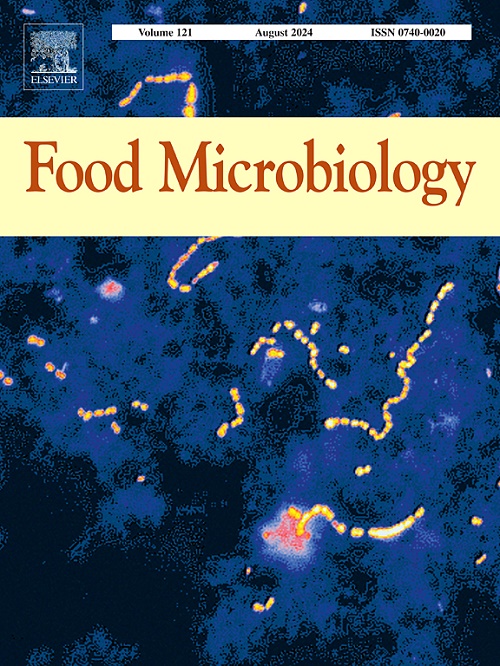Exploring viral diversity in fermented vegetables through viral metagenomics
IF 4.5
1区 农林科学
Q1 BIOTECHNOLOGY & APPLIED MICROBIOLOGY
引用次数: 0
Abstract
Fermented vegetables are traditionally produced using the endogenous microorganisms present in raw ingredients. While the diversity of bacteria and fungi in fermented vegetables has been relatively well studied, phage communities remain largely unexplored. In this study, we collected twelve samples of fermented cabbage, carrot, and turnip after fermentation and analyzed the microbial and viral communities using shotgun and viral metagenomic approaches. Assessment of the viral diversity also benefited from epifluorescence microscopy to estimate viral load. The viral metagenomics approach targeted dsDNA, ssDNA, and RNA viruses. The microbiome of fermented vegetables was dominated by lactic acid bacteria and varied according to the type of vegetable used as raw material. The analysis of metagenome-assembled-genomes allowed the detection of 22 prophages of which 8 were present as free particles and therefore detected in the metaviromes. The viral community, estimated to range from 5.28 to 7.57 log virus-like particles per gram of fermented vegetables depending on the sample, was mainly composed of dsDNA viruses, although ssDNA and non-bacterial RNA viruses, possibly originating from the phyllosphere, were also detected. The dsDNA viral community, primarily comprising bacteriophages, varied depending on the type of vegetable used for fermentation. The bacterial hosts predicted for these phages mainly belonged to Lactobacillaceae and Enterobacteriaceae families. These results highlighted the complex microbial and viral composition of fermented vegetables, which varied depending on the three types of vegetables used as raw material. Further research is needed to deepen our understanding of the impact of these viruses on the microbial ecology of fermented vegetables and on the quality of the final products.
利用病毒宏基因组学研究发酵蔬菜中的病毒多样性
发酵蔬菜传统上是使用原料中存在的内源性微生物生产的。虽然发酵蔬菜中细菌和真菌的多样性已经得到了相对较好的研究,但噬菌体群落在很大程度上仍未被探索。本研究收集了发酵后的12份白菜、胡萝卜和萝卜的发酵样品,采用散弹枪法和病毒宏基因组法对其微生物群落和病毒群落进行了分析。病毒多样性的评估也受益于荧光显微镜估计病毒载量。病毒宏基因组学方法针对的是dsDNA、ssDNA和RNA病毒。发酵蔬菜的微生物群以乳酸菌为主,并根据原料蔬菜的种类而变化。对宏基因组组装基因组的分析允许检测22个前噬菌体,其中8个以自由颗粒的形式存在,因此在中病毒组中检测到。根据样品的不同,病毒群落估计在每克发酵蔬菜5.28至7.57个对数病毒样颗粒之间,主要由dsDNA病毒组成,尽管也检测到可能起源于层球的ssDNA和非细菌RNA病毒。dsDNA病毒群落,主要由噬菌体组成,根据用于发酵的蔬菜类型而变化。预测的噬菌体宿主细菌主要属于乳酸杆菌科和肠杆菌科。这些结果突出了发酵蔬菜中复杂的微生物和病毒组成,这取决于作为原料的三种蔬菜类型。需要进一步的研究来加深我们对这些病毒对发酵蔬菜的微生物生态和最终产品质量的影响的理解。
本文章由计算机程序翻译,如有差异,请以英文原文为准。
求助全文
约1分钟内获得全文
求助全文
来源期刊

Food microbiology
工程技术-生物工程与应用微生物
CiteScore
11.30
自引率
3.80%
发文量
179
审稿时长
44 days
期刊介绍:
Food Microbiology publishes original research articles, short communications, review papers, letters, news items and book reviews dealing with all aspects of the microbiology of foods. The editors aim to publish manuscripts of the highest quality which are both relevant and applicable to the broad field covered by the journal. Studies must be novel, have a clear connection to food microbiology, and be of general interest to the international community of food microbiologists. The editors make every effort to ensure rapid and fair reviews, resulting in timely publication of accepted manuscripts.
 求助内容:
求助内容: 应助结果提醒方式:
应助结果提醒方式:


